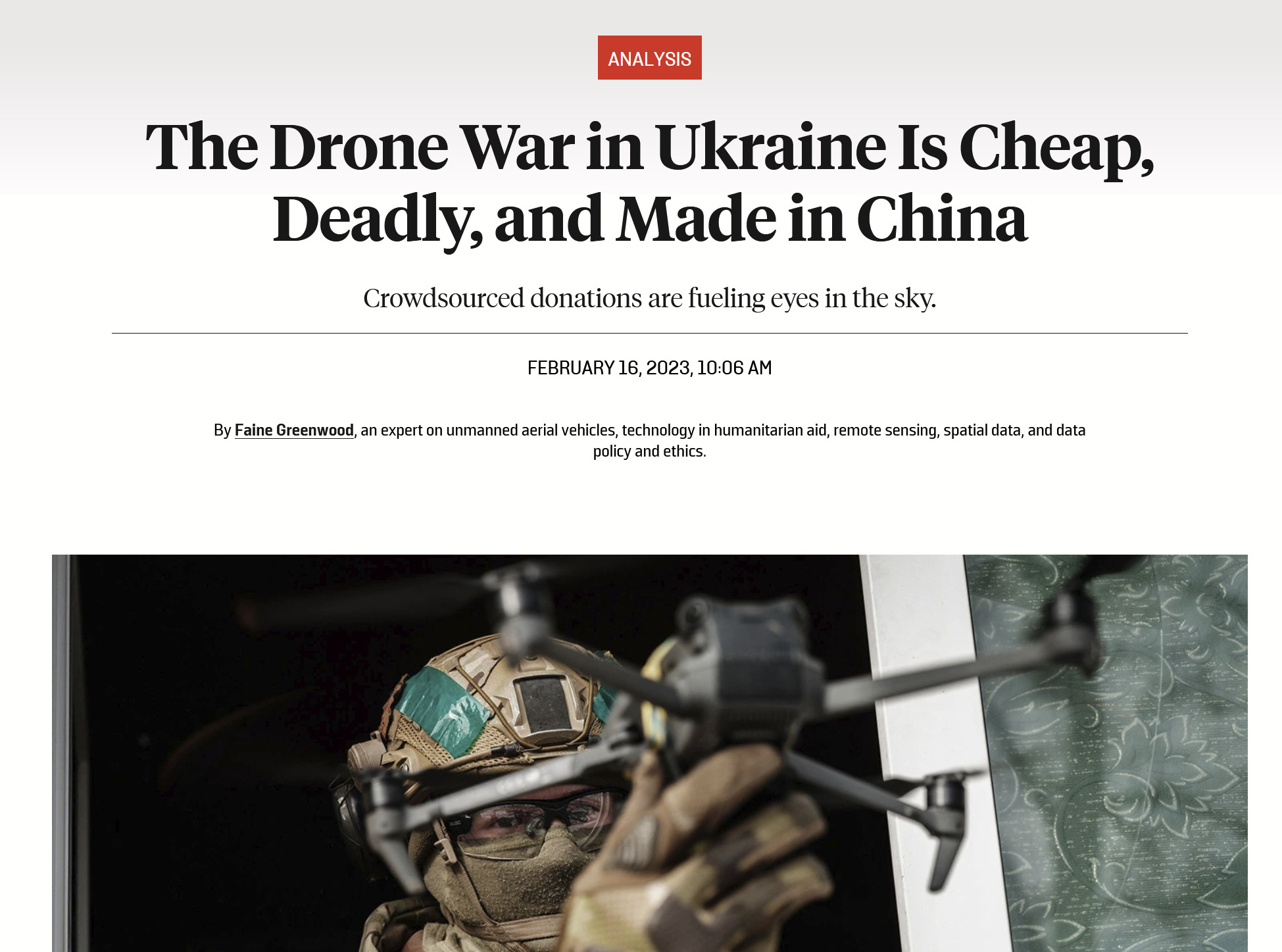A Year of Drones in the Ukraine War
My Foreign Policy piece on a year of dronewatching in the Ukraine conflict.
A little over a year ago, I started a database on drones in the Ukraine War. Now, it’s got almost 1000 entries. Almost 1000 examples of small drones being used to monitor battlefields, provide haunting visuals to reporter’s writing, document (possible) war crimes, scan over massive property destruction, drop grenades deftly into tanks, and slam themselves into the sides of armored vehicles. I’ve never seen anything like it. We’ve never seen anything like it.
I’d started thinking about building a drone database the week before Russia invaded, as Twitter filled up with more and more ominous talk about how Putin’s supposed bluff might transform into something, well, a lot more real. I knew that Ukraine was going to impress the world with its cheap-drone expertise because I’ve been following Ukrainian drone builders and pilots since the end of 2013 during the Euromaidan protests. They were going to hit the ground running, and I wanted to document what happpend in a relatively organized way. That’s where Google Sheets came in.
I followed hundreds of Telegram channels, asked friends who speak Ukrainian and Russian to translate, started talking a lot with DJI hackers, and watched approximately a gazillion hours of Ukraine war footage. I know I’ve only scratched the smallest surface of the vast sea of drone-related news and content coming out of this war: the enormity of it, how popular these things have become, is staggering. But I’ve seen enough to do some summarizing.
Here’s my recent Foreign Policy piece on drones in the Ukraine War. (Thanks again, James Palmer).

Here’s some facts and figures I calculated from the January 2023 version of my very non-scientific database, which didn’t make it into the FP piece. (They’re outdated now, as I’ve added more entires). They may be of interest.
DJI products are mentioned in the majority of the now-omnipresent Telegram requests for small drones and for funding to purchase drones, posted by fighters on both sides. Out of 898 entries as of 1/14/2023, the drone could not be identified in 460 cases (or 51%).
Out of the 438 entries where a drone identification could be made with some degree of confidence, DJI products of any kind were mentioned in 245 entries (56%). Of these 245 DJI mentions, the DJI Mavic appeared in 153 cases (62%). The other 193 identified drone types come are much more heterogeneous, including 33 mentions of multirotor products made by China’s Autel company, 14 mentions of drones custom-built by Aerorozvidka, and a number of other entries pertaining largely to small, fixed-wing drones.
What Are Drones Being Used For? I assigned multiple comma-separated key words to each incident under the “Purpose” column header, relying upon my own perception of what the drone was being used to do in each instance. While more analytical work needs to be done on this category, here’s a brief summary of my findings.
“Documentation” - describing using a drone to capture video or otherwise record what was going on during the conflict - was the most common keyword used: out of 898 entries, 445 (49.5%) were tagged with it. This is not surprising, due to how small drones are perhaps most useful as “eyes in the sky” - aerial tools for evaluating the world beyond the human view. “Targeting,” cases in which a drone is explicitly used to help target artillery or other long-range strikes on specific targets, appeared as a keyword in 176 cases, or 19.5%.
“Targeting” and “documentation” appeared as paired keywords very often in my dataset, in 153 cases: this is also not surprising, as these two functions are closely linked. Other commonly-appearing keywords including “bombing” referring to the use of drones to drop objects (112 cases) and “offensive” (essentially identical) at 113 cases: the two keywords were paired in some permutation in 153 instances.
“Donation” was the stated purpose of the social media post pertaining to drones in 99 cases - including common Telegram fundraising drives for drones - and “commentary” (editorial thoughts and observations from combatants and observers) accounted for 65 entries. 81 entries included the keyword “journalism,” highlighting the continuing usefulness of drone technology for reporting purposes. 31 entries contained keywords related to anti-drone or counter-drone technologies.
Telegram Provides the Most Info. Out of 898 entries, Telegram was the source for 570, followed by Twitter (159) and Facebook (54). I did not attempt to find the truly original source for most posts; however, it was clear that Telegram represented the most “original,” or oldest source for most information compiled here, and appeared to contain the most information directly sourced from people on the ground in Russia or Ukraine.
Official Ukrainian government sources often post drone footage directly to Facebook pages, which most battalions appear to have set up and regularly update. A number of popular Twitter OSINT accounts function as aggregators of information that they largely source from Telegram: unfortunately, a number of these accounts do not link to their original sources, making it difficult to determine where the media they post actually came from. I avoided linking to these accounts as sole or primary sources whenever possible (although sometimes I will link to them as duplicates or backups).
Out of 898 entries to date, the source who posted the data to social media (which often may differ from the source who actually collected the media, which is harder to determine) appeared to be supportive of, or was affiliated with, Ukraine in 431 cases (47.9%). Russian-affiliated sources represented 351 (39%) entries. 107 entries affiliation (11%) could not be clearly determined.
